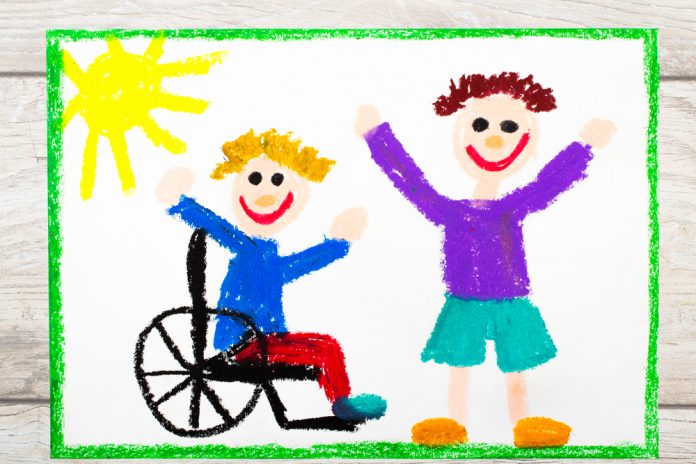
By David and Mercedes Rizzo
The sacrament of Penance can be difficult for some people with special needs. This sacrament may pose a challenge for those with intellectual disabilities, limited language skills, or difficulty distinguishing right actions from wrong actions. For instance, many individuals with autism, Down syndrome, and other cognitive disabilities, have trouble expressing and understanding emotions such as remorse and contrition. Additionally, it can present access issues for people with hearing impairments and physical disabilities. Fortunately religious education programs can be designed with these barriers in mind. When the proper supports are put into place, individuals with special needs can achieve success in receiving this important sacrament.
The bishops of the United States have laid out guidelines for receipt of this sacrament for those with intellectual disabilities. Emphasis is placed on the ability to show contrition, even if in a non-verbal way, and explicitly supports the use of the alternative communication system in which the person is most fluent. These guidelines encourage confessors to work with families to learn how individuals with special needs communicate, so they can be as independent as possible in the confessional. The bishops likewise present guidelines for physical access for those who use wheelchairs where access to a confessional may not be possible.
We offer the following tips to help pastors, parish catechetcal leaders, and catechists prepare children with special needs to receive the sacrament of Penance.
1 – Work on finding ways to distinguish right and wrong actions. This can be done in creative ways using cards, videos, and drawings.
People with intellectual and developmental disabilities may need to be taught how to distinguish between right actions and wrong actions. They may already have a limited understanding that can be developed by learning to match or sort out actions as right or wrong. Since people with special needs often respond best to pictures, catechists may use pictures of actions, or PECS (Picture Exchange Communication System) icons, to teach which actions are right and which are wrong. Students can be taught to point to, place or sort these pictures into the correct category using hand over hand or other prompts.
2 – Use prompts and reinforcement to help children with intellectual disabilities learn required content and develop the skills they need to successfully receive the sacrament of Penance.
Students with intellectual disabilities of all sorts may learn better when instructors use prompts and reinforcement. Prompts lead a student to the correct response, such as giving an answer to a question or learning a physical skill. There are different types of prompts that teachers can use such as hand over hand prompts, gestural prompts, and verbal prompts. Prompts are very important during the early stages of learning and can make a big difference for those with intellectual disabilities.
Reinforcement is a reward given to the student when they have given a correct response. The types of prompts and reinforcement that work best for individuals with special needs vary greatly so it is important for DRE’s and catechists to speak with parents to find out what has proven most successful in the past.
3 – Sit down with the child, family, and pastor to decide if the individual should use a confessional versus a reconciliation room (face-to-face).
Each person with special needs is an individual with different needs and abilities. Some will have no difficulty using a confessional and interacting with the priest through a screen. Others may not be able to do this, and their needs may best be met by using a reconciliation room.
The bishop’s guidelines specifically mention providing such an option for people who use wheelchairs. The bishops state that “every effort should be made to ensure that penitents who are wheelchair users have access to both face-to-face and private confessionals, with due regard for the right of the priest to insist on confession behind a fixed screen.”
People with attention deficits, hearing and visual impairments, or intellectual disabilities may also have difficulty using a confessional. Therefore, it is important that parents, guardians and others, as well as the child, be involved and give their in-put.
4 – Decide how the child will confess and make their contrition known.
People with intellectual and other language disorders who use electronic or augmentative communication systems to express themselves can use these same devices during confession. In fact, the bishops specifically say that they should use the communication system in which the person is most fluent. For some this means verbal speech. For others it may mean using a picture exchange system, electronic device, or sign language. Sometimes a person will use more than one technique.
Nonverbal persons with limited cognitive abilities can express their contrition with an “I’m Sorry” icon which they give to the priest. Others with more verbal and cognitive abilities may confess individual sins, perhaps by using a picture based examination of conscience.
The bishops address methods of communication in detail for those who are deaf.
Catholics who are deaf should have the opportunity to confess to a priest able to communicate with them in sign language, if sign language is their primary means of communication. They may also confess through an approved sign language interpreter of their choice. The interpreter has the obligation to observe secrecy. When neither a priest with signing skills nor a sign language interpreter is available, Catholics who are deaf should be permitted to make their confession in writing or through the use of an appropriate portable electronic communication device that can be passed back and forth between the penitent and confessor. The written or digital materials are to be returned to the penitent and properly destroyed or deleted.
(Guidelines for the Celebration of the Sacraments with Persons with Disabilities, Paragraph 30)
5 – Facilitate interaction early on between families, individuals with special needs, and confessors to maximize independence in the confessional.
Due to the importance placed on the seal of the confessional, children with special needs must learn to be as independent as possible when they receive the sacrament of Penance. This means that the priest hearing confession must be educated in how to prompt such children to initiate the sacrament and make a good confession within the limits of the child’s ability. Parish catechetical leaders and catechists can work with families, children, and priests to ensure that everyone knows what to do when the time comes. Parents are most familiar with the ways their children communicate and learn. It’s important that a parent be involved in showing the priest how to prompt their children to use preferred communication tools and strategies before they enter the confessional. Starting to address issues early on in the process leaves time to work out complex barriers such as finding priests who can sign or other approved sign language interpreters.
As you can see, the sacrament of Penance poses unique challenges for people with special needs of all sorts. However, these challenges can be overcome with proper planning and preparation that involves all parties, especially families of those involved.
DAVID AND MERCEDES RIZZO write and speak from a faith perspective as parents of a child with autism. Find their books,The Adaptive First Eucharist Preparation Kit, Spiritually Able, and Faith, Family, and Children with Special Needs, as well as Praying for Your Special Needs Child at DavidAndMercedesRizzo.com.
:::
Image credit: Joanna Dorota / ShutterStock 742215487




